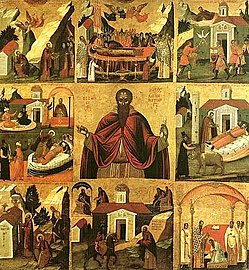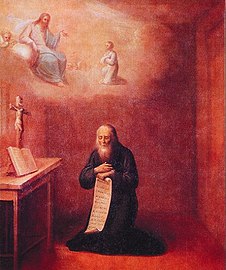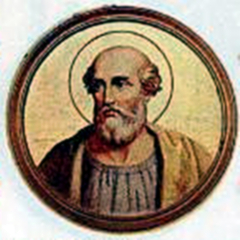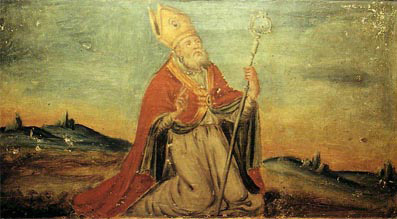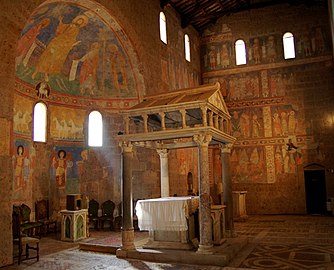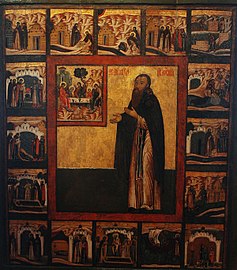January 11 (Eastern Orthodox liturgics)
Appearance

January 10 - Eastern Orthodox liturgical calendar - January 12
All fixed commemorations below are observed on January 24 by Eastern Orthodox Churches on the Old Calendar.[note 1]
For January 11th, Orthodox Churches on the Old Calendar commemorate the Saints listed on December 29.
Feasts
[edit]- Afterfeast of the Theophany of Our Lord and Savior Jesus Christ.[1][2]
Saints
[edit]- Martyr Mairus (Mairos).[3][note 2]
- Martyrs Peter, Severius and Leucius, at Alexandria.[5]
- Venerable Theodosius of Antioch, ascetic of Rhosus and Antioch, Wonderworker (412)[1][6] (see also: February 5 - Greek)
- Venerable Theodosius the Cenobiarch (Theodosius the Great) (529)[1][7][8][note 3]
- Venerable Theodorus, and Venerable Archimandrite Agapius of Apamea in Syria.[1][9]
- Venerable Vitalis of Gaza (Vitalios), of the monastery of Abba Seridus at Gaza (c. 609 - 620)[1][10]
Pre-Schism Western saints
[edit]- Hieromartyr Hyginus, Pope of Rome (142)[1][11][12][note 4]
- Saint Leucius of Brindisi, venerated as the first Bishop of Brindisi, where he had come as a missionary from Alexandria (180)[12]
- Hieromartyr Alexander of Fermo, Bishop, martyred under Decius (c. 250)[12][note 5]
- Saints Ethenia and Fidelmia, Princesses, daughters of King Laoghaire in Ireland, veiled as nuns by St Patrick (433)[12]
- Martyr Salvius, in North Africa, eulogized by St Augustine.[12]
- Saint Brandan, Abbot, opponent of Pelagianism (5th century)[12][note 6]
- Saint Honorata, nun, sister of St. Epiphanius of Pavia, who ransomed her after she was abducted from the monastery of St. Vincent in Pavia (c. 500)[12]
- Saint Anastasius of Castel Sant'Elia, Abbot (c. 570)[12][note 7][note 8]
- Saint Boadin the Irish, hermit in Gaul.[12]
- Saints Paldo, Taso and Tato, three brothers, Abbots of San Vincenzo on the Voltorno (8th century)[12][note 9]
- Paulinus II of Aquileia, Enlightener of the Slovenes (d. 804).
Post-Schism Orthodox saints
[edit]- Venerable Theodosius of Mt. Athos, Metropolitan of Trebizond (1392.)[1][14][15]
- Venerable Michael of Klopsk, of Klopsk Monastery in Novgorod, Fool-for-Christ and Wonderworker (1456)[1][16][17]
- New Martyr Nikephoros of Crete, by hanging, for renouncing Islam and confessing his faith in Christ (1832)[18]
- Saint Joseph the New of Cappadocia (c. 1860)[1][19][note 10]
New martyrs and confessors
[edit]- Nicholas Matsievsky of Perm
- Theodore Antipin of Perm
- Vladimir Fokin of Krasnoyarsk
- New Hiero-Confessor Vladimir (Khirasko), Archpriest, of Minsk (1932)[1][21]
Other commemorations
[edit]- Synaxis of the Myriads of Holy Angels (Synaxis of the Myriangelon).[22][note 11]
- Consecration of the Church of St. Stephen in Placidia Palace, Constantinople.[1][23]
- Chernigov-Eletskaya Icon of the Most Holy Theotokos (1060)[1][24]
- Repose of Blessed Nun Eupraxia of Teliakov village, Kostroma (1823)[1][25]
Icon gallery
[edit]-
Venerable Theodosius the Cenobiarch.
-
Saint Vitalis of Gaza .
-
Hieromartyr Hyginus, Pope of Rome.
-
Saint Leucius of Brindisi.
-
Interior of the Basilica di Sant'Elia, where Saint Anastasius was Abbot.
-
Icon of St. Michael of Klopsk.
Notes
[edit]- ^ The notation Old Style or (OS) is sometimes used to indicate a date in the Julian Calendar (which is used by churches on the "Old Calendar").
The notation New Style or (NS), indicates a date in the Revised Julian calendar (which is used by churches on the "New Calendar"). - ^ It is unknown where and when St. Mairus was martyred for Christ. One hagiography mentions that he is probably same saint as the Holy Maioros (or Maionos) who is celebrated on February 15. But Archbishop Sergiy (Spassky) affirmed definitely that Martyr Major of Gaza under Diocletian is a different person in view of different liturgical verses.[4]
- ^ Theodosius the Great (also Theodosius the Cenobiarch), was a founder and organizer of the cenobitic way of monastic life. The monastery that he founded in 476 AD became known as the "Monastery of St. Theodosius", and includes his tomb. It was founded east of the village of al-Ubeidiya (ancient Cathismus) in the West Bank, 12 kilometres east of Bethlehem. The current structure was built by the Crusaders in the 12th century. It is located on a hilltop and is under the administration of the Greek Orthodox Church of Jerusalem.
- ^ "AT Rome, the birthday of St. Hyginus, pope, who suffered a glorious martyrdom in the persecution of Antoninus."[13]
- ^ Born in Fermo near Ancona in Italy, he became bishop of his native city and was martyred under Decius. His relics are enshrined in the Cathedral.
- ^ Born in Ireland, he took refuge from Pelagianism in Britain and then in France, at a monastery where he became abbot.
- ^ A notary of the Roman church, he became monk and Abbot of Castel Sant' Elia in Italy. St Gregory the Great narrates that St Anastasius and his monks reposed, at the call of an angel, in quick succession.
- ^ "At Suppentonia, near Mount Soractes, the holy monk Anastasius, and his companions, who were called by a voice from heaven to enter the kingdom of God."[13]
- ^ Three brothers, born in Benevento in Italy, who became monks at Farfa and eventually founded the monastery of San Vincenzo at the headwaters of the Volturno. Of this they successively became abbots, Paldo reposing in c. 720, Taso in c. 729, and Tato in c. 739.
- ^ Although January 11 is given on some calendars as the feast day for Saint Joseph the New of Cappadocia ((in Greek): ῾Ο ῞Οσιος ᾿Ιωσὴφ ὁ Νέος ὁ ἐν Καππαδοκίᾳ), in his Life by the Orthodox Church of Greece (Holy Synod in Resistance), it indicates that St. Joseph has a Moveable feast day, which is celebrated on the Sunday after Theophany.[20]
- ^ The feast of the Synaxis of the Myriads of Holy Angels was celebrated in the Martyrium of Saint Anastasia, "in the embolus of Domninus". The Temple of the Myriangelon ( The Church of the Myriads of Holy Angels) was especially renowned in the 6th century for the services in honour of the many miracles that were attributed to them.
References
[edit]- ^ a b c d e f g h i j k l m January 11/January 24. Orthodox Calendar (PRAVOSLAVIE.RU).
- ^ Afterfeast of the Theophany of our Lord and Savior Jesus Christ. OCA - Lives of the Saints.
- ^ Great Synaxaristes: (in Greek) Ὁ Ἅγιος Μάϊρος. 11 Ιανουαρίου. ΜΕΓΑΣ ΣΥΝΑΞΑΡΙΣΤΗΣ.
- ^ Сергий (Спасский), архиеп. Полный месяцеслов Востока. Том II Святой восток. Февраль. 15
- ^ Great Synaxaristes: (in Greek) Οἱ Ἅγιοι Πέτρος, Σεβέριος καὶ Λεύκιος οἱ Μάρτυρες. 11 Ιανουαρίου. ΜΕΓΑΣ ΣΥΝΑΞΑΡΙΣΤΗΣ.
- ^ St Theodosius of Antioch. OCA - Lives of the Saints.
- ^ Great Synaxaristes: (in Greek) Ὁ Ὅσιος Θεοδόσιος ὁ Κοινοβιάρχης καὶ Καθηγητὴς τῆς Ἐρήμου. 11 Ιανουαρίου. ΜΕΓΑΣ ΣΥΝΑΞΑΡΙΣΤΗΣ.
- ^ Venerable Theodosius the Great, the Cenobiarch. OCA - Lives of the Saints.
- ^ Great Synaxaristes: (in Greek) Οἱ Ὅσιοι Θεόδωρος καὶ Ἀγάπιος ὁ Ἀρχιμανδρίτης. 11 Ιανουαρίου. ΜΕΓΑΣ ΣΥΝΑΞΑΡΙΣΤΗΣ.
- ^ Great Synaxaristes: (in Greek) Ὁ Ὅσιος Βιτάλιος. 11 Ιανουαρίου. ΜΕΓΑΣ ΣΥΝΑΞΑΡΙΣΤΗΣ.
- ^ Great Synaxaristes: (in Greek) Ὁ Ἅγιος Ὑγίνος Ἐπίσκοπος Ρώμης. 11 Ιανουαρίου. ΜΕΓΑΣ ΣΥΝΑΞΑΡΙΣΤΗΣ.
- ^ a b c d e f g h i j January 11. Latin Saints of the Orthodox Patriarchate of Rome.
- ^ a b The Roman Martyrology. Transl. by the Archbishop of Baltimore. Last Edition, According to the Copy Printed at Rome in 1914. Revised Edition, with the Imprimatur of His Eminence Cardinal Gibbons. Baltimore: John Murphy Company, 1916. pp.11-12.
- ^ Great Synaxaristes: (in Greek) Ὁ Ὅσιος Θεοδόσιος Ἐπίσκοπος Τραπεζοῦντος. 11 Ιανουαρίου. ΜΕΓΑΣ ΣΥΝΑΞΑΡΙΣΤΗΣ.
- ^ Venerable Theodosius the Metropolitan of Trebizond. OCA - Lives of the Saints.
- ^ Great Synaxaristes: (in Greek) Ὁ Ἅγιος Μιχαὴλ ὁ διὰ Χριστὸν Σαλός καὶ Θαυματουργὸς. 11 Ιανουαρίου. ΜΕΓΑΣ ΣΥΝΑΞΑΡΙΣΤΗΣ.
- ^ Venerable Michael the Fool-for-Christ of the Klops Monastery, Novgorod. OCA - Lives of the Saints.
- ^ Great Synaxaristes: (in Greek) Ὁ Ἅγιος Νικηφόρος ὁ Νεομάρτυρας ἐκ Κρήτης. 11 Ιανουαρίου. ΜΕΓΑΣ ΣΥΝΑΞΑΡΙΣΤΗΣ.
- ^ a b The Autonomous Orthodox Metropolia of Western Europe and the Americas (ROCOR). St. Hilarion Calendar of Saints for the year of our Lord 2004. St. Hilarion Press (Austin, TX). p.7.
- ^ St. Joseph the New of Cappadocia. Holy Synod in Resistance of the Orthodox Church in Greece. Retrieved: 2013-02-27.
- ^ a b January 24 / January 11. HOLY TRINITY RUSSIAN ORTHODOX CHURCH (A parish of the Patriarchate of Moscow).
- ^ Great Synaxaristes: (in Greek) Σύναξις τῶν Μυρίων Ἁγίων Ἀγγέλων. 11 Ιανουαρίου. ΜΕΓΑΣ ΣΥΝΑΞΑΡΙΣΤΗΣ.
- ^ Great Synaxaristes: (in Greek) Ἐγκαίνια Ναοῦ τοῦ Ἁγίου Στεφάνου τοῦ ἐν Πλακιδιαναῖς. 11 Ιανουαρίου. ΜΕΓΑΣ ΣΥΝΑΞΑΡΙΣΤΗΣ.
- ^ Icon of the Mother of God of Elets. OCA - Feasts and Saints.
- ^ Great Synaxaristes: (in Greek) Ἡ Ὁσία Εὐπραξία ἐκ Ρωσίας. 11 Ιανουαρίου. ΜΕΓΑΣ ΣΥΝΑΞΑΡΙΣΤΗΣ.
Sources
[edit]- January 11/January 24. Orthodox Calendar (PRAVOSLAVIE.RU).
- January 24 / January 11. HOLY TRINITY RUSSIAN ORTHODOX CHURCH (A parish of the Patriarchate of Moscow).
- January 11. OCA - The Lives of the Saints.
- The Autonomous Orthodox Metropolia of Western Europe and the Americas (ROCOR). St. Hilarion Calendar of Saints for the year of our Lord 2004. St. Hilarion Press (Austin, TX). p. 7.
- January 11. Latin Saints of the Orthodox Patriarchate of Rome.
- The Roman Martyrology. Transl. by the Archbishop of Baltimore. Last Edition, According to the Copy Printed at Rome in 1914. Revised Edition, with the Imprimatur of His Eminence Cardinal Gibbons. Baltimore: John Murphy Company, 1916. pp. 11–12.
Greek Sources
- Great Synaxaristes: (in Greek) 11 ΙΑΝΟΥΑΡΙΟΥ. ΜΕΓΑΣ ΣΥΝΑΞΑΡΙΣΤΗΣ.
- (in Greek) Συναξαριστής. 11 Ιανουαρίου. ECCLESIA.GR. (H ΕΚΚΛΗΣΙΑ ΤΗΣ ΕΛΛΑΔΟΣ).
Russian Sources
- (in Russian) 24 января (11 января). Православная Энциклопедия под редакцией Патриарха Московского и всея Руси Кирилла (электронная версия). (Orthodox Encyclopedia - Pravenc.ru).
- (in Russian) 11 января (ст.ст.) 24 января 2013 (нов. ст.). Русская Православная Церковь Отдел внешних церковных связей. (DECR).

